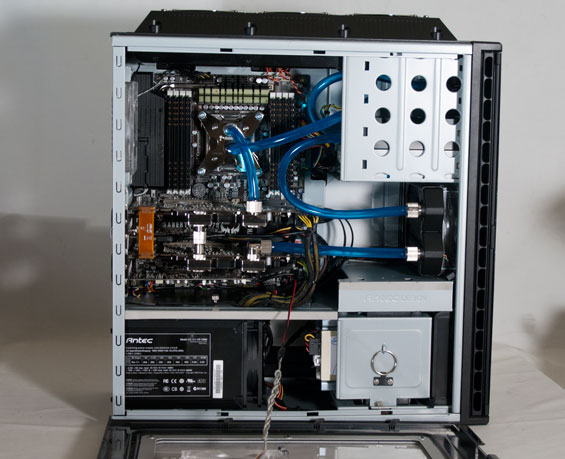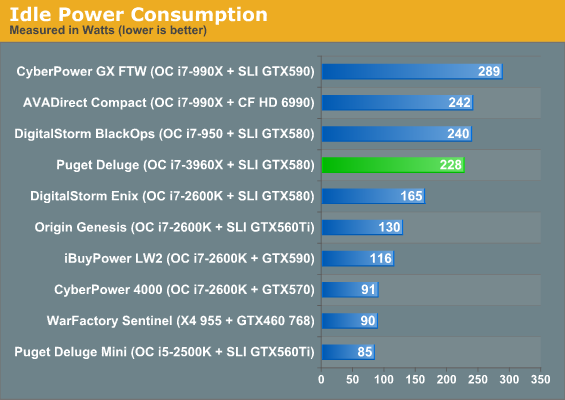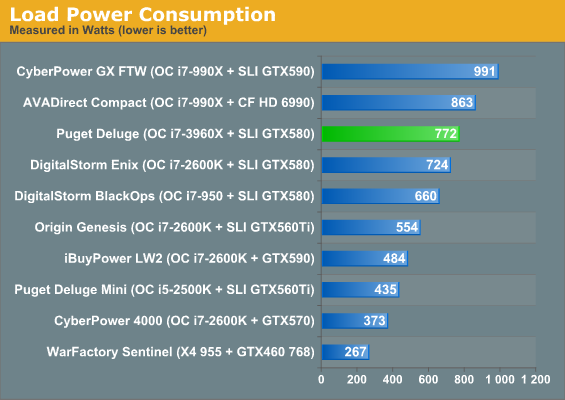Puget Systems Deluge: Revisiting the Art of Custom With X79
by Dustin Sklavos on November 24, 2011 12:00 AM EST- Posted in
- Systems
- Gaming
- Intel
- Puget Systems
- mid-tower
- Water Cooling
- NVIDIA
Build, Heat, and Power Consumption
Cutting to the chase, the Deluge's physical build quality is, as has been the case with all Puget Systems machines we've tested, basically unimpeachable. The modifications made to the Antec P183 enclosure are clean, and the wiring and liquid-cooling routing are top notch. I was actually impressed with the work they did installing a window on the side panel; the P183's inside panels are acoustically padded in a way that might make modification challenging, but you wouldn't know it to look at the Deluge.
I'm also impressed they were able to make a computer with a window on the side and glowing blue fans and tubing not look incredibly gaudy. While I think blue LEDs are starting to feel played out, this looks and feels like a powerful custom machine. It's hard not to be taken aback when you look at it. The thing weighs a ton, but what did you expect?

Where Puget Systems unfortunately falters is the overclock. They don't allow the idle voltage to drop on the i7-3960X, forcing it to constantly run between 1.41 and 1.46 volts. Ignoring for a moment that those are pretty high voltages (and undoubtedly necessary to hit the punishing 4.6GHz overclock), I'm actually disheartened to see a company that's normally a wonderful citizen where power consumption is concerned trip up in this area. I gripe about lazy overclocks pretty frequently, but this is really a situation where they should've known better and done more tuning. Blame the newness of the platform if you want (which is almost certainly a factor), but the result is a processor that's running hotter at idle than it needs to, a cooling system that has to work a little harder than it should, and power consumption that's pretty dire.

Despite the custom liquid-cooling loop with a 360mm radiator and an additional 120mm radiator in the front, the i7-3960X still runs a bit toasty under load, and those idle temperatures are quite poor. Again, though, that's what happens when you dump so much voltage into a processor and don't let it scale down at idle. The Deluge essentially needs the liquid-cooling loop to maintain the overclock. Higher temperatures generally go hand in hand with higher power consumption, and that's precisely what we see.


Given the improvements in SNB-E and X79 relative to Gulftown and X58, we were hoping for a better showing. At idle, only the last generation Nehalem in the DigitalStorm BlackOps and Gulftowns in the CyberPower and AVADirect rigs are worse, and the CyberPower and AVADirect rigs are both powering four GPUs.
Things get even worse under load; only the quad-GPU rigs running Gulftown are able to draw more power than the Puget Deluge. You can argue that DigitalStorm's Enix makes things at least look a little better, but we actually took DigitalStorm to task over the overclock in their system: its voltage idles low but shoots through the roof when the i7-2600K is placed under load.
I'm going to keep dinging boutiques on these overclocks until they start paying attention: "fastest" does not mean "best," especially not when it results in this kind of heat and power consumption. It's one thing to set a speed record for the Futuremark ORB or an overclocking competition, but it's quite another matter to sell a system designed to run daily tasks for the next few years. The Deluge is plenty fast, but long-term it could really benefit from some additional tuning.
















72 Comments
View All Comments
vanadiel - Thursday, November 24, 2011 - link
I don't understand for the life of me why anyone would purchase a system like this for over $7K.While it's true that this system will ensure top notch gaming, so will a system that costs 5 times less.
I benched my own system to compare the scores, and while I got beaten on every number, the beating was merely a little tap on the shoulder.
If I would pay this much for a system I would expect it to crush and utterly demolish my current gaming system.
Beenthere - Thursday, November 24, 2011 - link
No one would actually buy a system like this unless they were technically PC illiterate. This is a system for posers with more money than knowledge.vanadiel - Friday, November 25, 2011 - link
Maybe, but it's not much of a pose if you get beaten. A system like this has to have stellar performance or there's no point in purchasing it.Beenthere - Saturday, November 26, 2011 - link
Which is exactly why no one but a poser would buy it. ;)mariush - Thursday, November 24, 2011 - link
Mass storage is handled by a Western Digital Caviar Black 2TB drive, and given the current shortages in the industry as a result of the Thailand flooding, you pay dearly for the privilege.Yeah, right. I'm sure the price of a 2 TB hard drive really matters in the total of 7500$ for this system system.
Catalina588 - Thursday, November 24, 2011 - link
I too was surprised by the high voltage used in the factory OC, as well as the permanent 1.4+ volt load on the processor. I don't see the benefits of that overclock. Here are two scenarios:1. Always at 100% CPU Utilization
If you're running simulations constantly (e.g., Folding@Home), then the cooling limits of your setup will drive the possible OC. I set my Turbo to 43X BCLK 100 for a 4.3GHz boot on 6 cores. After 10 minutes, CPU-Z reports the core speed has dropped to the thermal stability point of my Intel HSC water-loop: 4.1 GHz at less than 80 degrees package temperature (via Core Temp) with a voltage of 1.104. Looks like it could run this way for a long time with no sweat.
2. Occasional high-performance single threads
Set the Turbo multiplier to 48X. Leave all the Intel SpeedStep technology enabled. If it boots, run your burn-in tests and you should be fine. If not, try a lower Turbo multiplier The processor will spool all 6 cores up to 48X briefly (seconds) or a couple of cores for long runs. If you're doing a long video transcode, you'll see the core speed decline from 48X as the TDP thermal limits are met and throttled back. With this method, most of the time you'll benefit from the energy savings running at lower voltage and lower core speeds at idle.
Death666Angel - Friday, November 25, 2011 - link
Not a very sophisticated overclock, if you rely on thermal throttling.Also, if your CPU throttles (but there is more overclock to be had) you might want to think about getting better cooling, because 1.1V and 4.1GHz seems quite conservative on moderate to good air cooling. Seems like you have bad to moderate cooling in your rig.
My CPU (i7 860) is not limited by temperature (75°C @1.408V+4.05GHz) but by normal manufacturing errors. Even a small spike at 1.5V didn't result in better OC and gave me errors after a few minutes on LinX.
Even if it was limited by temperature, I wouldn't let it just throttle, I'd tweak it to get the best non-throttle overclock.
But there are enough good OC manuals out there. :D
jadawgis732 - Thursday, November 24, 2011 - link
I think the conclusion here smacks of real, independent speak, which is not something you find in spades in this day in age when every reviewer is just writing it as nicely as possible in order to keep in high standing with manufacturers. I love the "good citizen" line in the power section too. Just one mistake, on the conclusion page, after you finish ripping apart Puget's placement strategy and pricing scheme you say, "[...] having six cores, but it's not like anyone gamers have been crying that [...]" Anyway keep up the great work.McFoozle - Friday, November 25, 2011 - link
1. Intel Sandy Bridge-E is a bust. By the time it starts providing the necessary performance per dollar to make sense, Ivy Bridge will be out.2. This system doesn't even make sense for people with money to burn who don't have time to spend on building it themselves.
3. Boutique systems builders obviously charge big money to build these things for you and they almost always do things that are weird, undesired and even downright inexplicable.
piroroadkill - Friday, November 25, 2011 - link
I agree that Sandy Bridge-E is pointless for almost everyone.Also, the sort of person that would buy the best ULTRA EXXXXTREME edition processor would already have a Core i7-980x or 990x system, and would STILL have no reason to upgrade to this.
Everyone's better off waiting for Ivy Bridge.